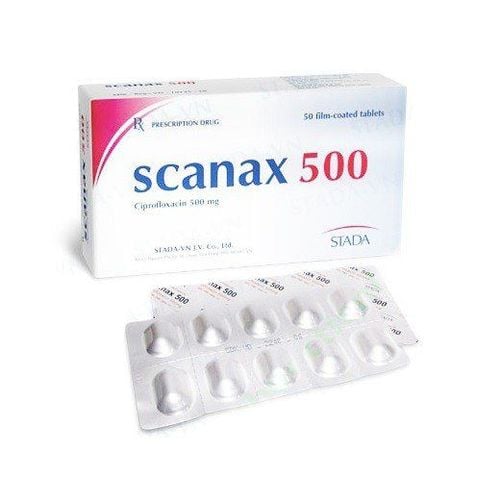This is an automatically translated article.
Trimexazol 240 is prepared in the form of powder for oral suspension. The main ingredients of the drug include Sulfamethoxazol and Trimethoprim, used in cases of infection, bacterial infection.
1. Uses of Trimexazol 240
What is Trimexazol? 1 pack of Trimexazol 2.5g contains 200mg Sulfamethoxazole + 40mg Trimethoprim. Sulfamethoxazole in combination with Trimethoprim creates a synergistic effect that increases the effectiveness of treatment and reduces drug resistance. Sulfamethoxazole has a broad spectrum of activity against a wide range of gram-negative and gram-positive aerobic bacteria.Indications to use Trimexazol:
Treatment of respiratory tract infections: Sinusitis, exacerbation of chronic bronchitis, otitis media, acute cheek sinusitis in adults, acute pneumonia in children; Treatment of kidney - urinary infections: Cystitis, acute and chronic prostatitis, pyelonephritis, urinary tract infections; Treatment of digestive tract infections: Typhoid, chronic dysentery, especially infections caused by E.coli, Shigella, Salmonella; Treatment of bacterial infections, pneumonia caused by Pneumocystis jiroveci. Contraindications to the use of Trimexazol:
People who are sensitive to the ingredients and excipients of the drug; In patients with severe renal failure, plasma drug concentrations cannot be monitored; Patients with megaloblastic anemia (caused by folic acid deficiency); People with liver damage; Children under 2 months old; Pregnant and lactating women.
2. Usage and dosage of Trimexazol 240
How to use: Orally, take medicine when full. Mix 1 sachet in 5ml of water. Then, shake well before use to obtain a uniformly soluble suspension.
Dosage:
Uncomplicated lower urinary tract infections: Adults: 800mg sulfamethoxazole + 160mg trimethoprim (4 packs), 12 hours apart, 10 days treatment; Children: 8mg trimethoprim/kg + 40mg sulfamethoxazol/kg, divided into 2 doses 12 hours apart, treatment for 10 days; Chronic recurrent urinary tract infections (adult women): Use low dose of 200mg Sulfamethoxazole + 40mg Trimethoprim (1 pack) per day or 2-4 times that dose, take the drug 1-2 times a week; Acute exacerbation of chronic bronchitis in adults: Use 4-6 sachets x 2 times/day, treat for 10 days; Acute otitis media, acute pneumonia in children: Children: 8mg trimethoprim/kg + 40mg sulfamethoxazol/kg in 24 hours, divided into 2 divided doses 12 hours apart, treatment for 5-10 days; Bacillary dysentery: Adults: 4 packs, 12 hours apart, 5 days treatment; Children: 8mg trimethoprim/kg + 40mg sulfamethoxazol/kg in 24 hours, divided into 2 divided doses 12 hours apart, treatment for 5 days; Pneumocystis jiroveci pneumonia: Dosage for children and adults is 20mg Trimethoprim/kg + 100mg sSulfamethoxazol/kg in 24 hours, divided equally 6 hours apart, treatment for 14-21 days. Patients with renal impairment: Adjust dose as follows: Creatinine clearance above 30ml/min: Use usual dose; Creatinine clearance 15 - 30ml/min: Take 1/2 dose of the usual dose; Creatinine clearance less than 15ml/min: Not indicated for use. Overdose: In case of emergency or overdose of Trimexazol, the patient should be taken to the nearest hospital for immediate examination and treatment. Manifestations of overdose include anorexia, nausea, vomiting, headache, unconsciousness, hematopoietic disorders and jaundice, and myelosuppression. Treatment includes: Induction of vomiting, gastric lavage, and acidification of urine to increase elimination of trimethoprim. If there are signs of myelosuppression, the patient is given leucovorin 5 - 15 mg/day until hematopoiesis is restored.
Missed dose: If a dose of Trimexazol is missed during the course of taking the drug, the patient should take it as soon as possible (usually it can be taken 1-2 hours before the indicated time). If it is almost time for the next dose, skip the missed dose and take the next dose at the prescribed time.
3. Side effects of the drug Trimexazol
When using Trimexazol, patients may experience some side effects such as:
Common: Fever, nausea, vomiting, diarrhea, glossitis, rash, itchy skin; Uncommon: Leukopenia, neutropenia, eosinophilia, purpura, urticaria; Rare: Anaphylaxis, serum sickness, thrombocytopenia, granulocytopenia, pancytopenia, hemolytic anemia, megaloblastic anemia, aseptic meningitis, Stevens- syndrome Johnson, Lyell's syndrome, erythema multiforme, angioedema, photosensitivity, hyperkalemia, hypoglycemia, jaundice, hepatic cholestasis, hepatic necrosis, hallucinations, tinnitus, renal failure, inflammation interstitial kidney, nephrolithiasis. Therefore, when taking the drug, if there is any abnormality, the patient should consult a doctor for appropriate advice.
4. Caution when using Trimexazol Some notes patients need to remember when using Trimexazol:
Be careful when using the drug in patients with impaired liver and kidney function; When taking the drug for more than 14 days in the elderly, the blood count should be checked. Patients should take an additional 5-10mg of folic acid/day; Use caution when using the drug in children under 15 years of age, patients with myasthenia gravis, stomach ulcers, hepatic coma,...; Trimexazol can cause hemolytic anemia in patients with G6PD deficiency; Monitor hematology when taking Trimexazol, especially when the patient has signs of blood disorders. The drug should be discontinued when a rash or abnormal blood changes occur; Closely monitor when using Trimexazol for HIV-infected patients because this group of patients has a high rate of side effects such as skin reactions, hematology, fever,...; Trimexazol drugs, if used during pregnancy, can cause adverse effects such as miscarriage, fetal malformations, ... especially if the drug is used in the first 3 months of pregnancy. Therefore, it is best not to use the drug in pregnant women. If medication is required, consult a doctor; The composition of the drug Trimexazol contains lactose, so the drug should not be used for people with galactose intolerance, lactase deficiency or glucose - galactose intolerance; Trimexazol can be passed on to an infant through breast-feeding. Therefore, it is best not to or limit the use of the drug during breastfeeding. Mothers should carefully read the instructions for use and consult a doctor before deciding to use the drug. 5. Drug interactions Trimexazol When using 2 or more drugs, drug interactions often occur, leading to antagonism or synergism. Some drug interactions of Trimexazol include:
Concomitant use of Trimexazol with diuretics (especially thiazides) increases the risk of thrombocytopenia in the elderly; Concomitant use of Trimexazol with Methotrexate may reduce elimination, increase the effect of Methotrexate; Concomitant use of Trimexazol with pyrimethamine over 25mg/week increases the risk of megaloblastic anemia; Trimexazol drugs inhibit the metabolism of phenytoin in the liver, increasing the effect of phenytoin; Trimexazol may prolong prothrombin time in patients taking warfarin; Concomitant administration of Trimexazol with cyclosporin may cause nephrotoxicity in renal transplant patients (reversible); Concomitant administration of Trimexazol with Digoxin increases serum digoxin concentrations (usually seen in the elderly). Serum digoxin levels should be monitored when these two drugs are combined; Co-administration of Trimexazol with indomethacin may increase plasma concentrations of sulfamethoxazole; Concomitant use of Trimexazol with tricyclic antidepressants may reduce the effectiveness of antidepressants; Taking Trimexazol with amantadine can cause toxic delirium. When taking Trimexazol, the patient should follow all instructions of the doctor on how to use, dose, and time of use. In addition, patients should inform their doctor about their medical history, medications and supplements they are taking. If experiencing adverse symptoms, the patient should immediately report to the doctor for timely intervention and management, to avoid unpredictable complications.
Please dial HOTLINE for more information or register for an appointment HERE. Download MyVinmec app to make appointments faster and to manage your bookings easily.













